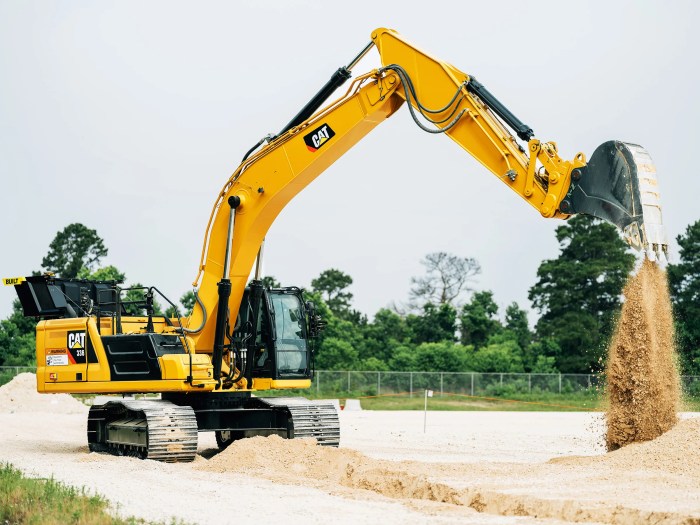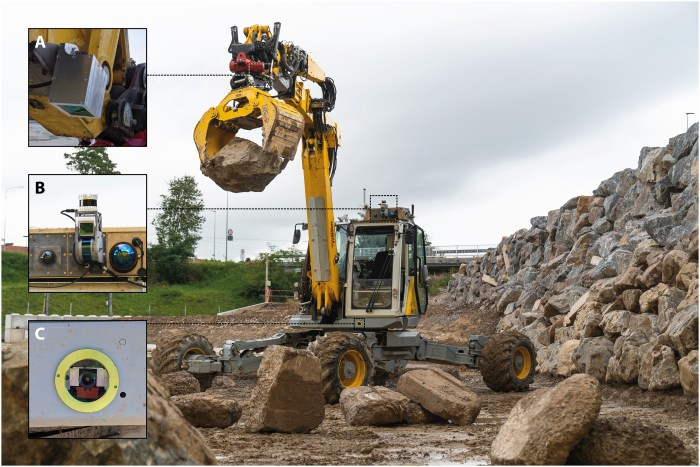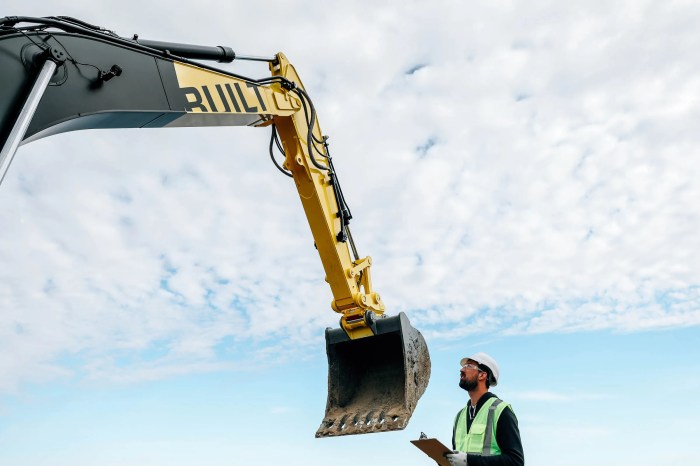Autonomous robotic digger construction is revolutionizing the way we build. These machines, powered by cutting-edge technology like GPS, sensors, and artificial intelligence, are transforming construction sites into efficient and safe environments. Imagine a future where robots handle the heavy lifting, digging, and excavating, freeing human workers to focus on more complex tasks.
This is the promise of autonomous robotic digger construction, and it’s already starting to reshape the industry.
The potential benefits of these robotic diggers are vast. Increased efficiency, reduced labor costs, and improved safety are just a few of the advantages. However, there are challenges to overcome, such as regulations, safety concerns, and the cost of implementation.
As we delve deeper into the world of autonomous robotic digger construction, we’ll explore the technology behind these machines, their real-world applications, and the future trends that will shape their development.
Introduction to Autonomous Robotic Digger Construction

Autonomous robotic digger construction refers to the development and deployment of self-operating machines for excavation and earthmoving tasks. These robots utilize advanced technologies such as sensors, artificial intelligence, and GPS to navigate, operate, and perform tasks without direct human intervention.
The key components of an autonomous robotic digger include:
Components of an Autonomous Robotic Digger
- Sensors:Autonomous diggers are equipped with various sensors, including cameras, lidar, and GPS, to perceive their surroundings, detect obstacles, and navigate accurately.
- Artificial Intelligence (AI):AI algorithms enable the robot to make decisions, plan routes, and control its movements based on real-time data from sensors.
- Control System:The control system coordinates the operation of the robot’s actuators, hydraulics, and other components to execute tasks precisely.
- Navigation System:GPS and other navigation systems allow the robot to locate itself accurately and follow pre-programmed routes or paths.
- Excavation Equipment:The robot is equipped with specialized excavation equipment, such as a digging bucket or a hydraulic arm, to perform earthmoving tasks.
Current State and Applications
Autonomous robotic digger construction is a rapidly evolving field with significant potential for various applications.
- Construction Sites:Autonomous diggers can improve efficiency and safety on construction sites by performing repetitive and hazardous tasks, such as digging trenches, foundations, and excavating materials. They can work around the clock, reducing project timelines and minimizing human error.
- Mining Operations:In mining, autonomous diggers can operate in challenging and dangerous environments, such as underground mines or open-pit operations. They can handle heavy loads, navigate complex terrain, and reduce the risk of accidents.
- Infrastructure Projects:Autonomous diggers can be deployed for infrastructure projects, such as road construction, bridge building, and pipeline installation. They can work efficiently in remote locations, minimizing environmental impact and reducing labor costs.
- Disaster Relief:Autonomous diggers can assist in disaster relief efforts by clearing debris, excavating rubble, and accessing difficult-to-reach areas. Their ability to operate autonomously makes them valuable tools in emergency situations.
Benefits and Challenges of Autonomous Robotic Digger Construction
The integration of autonomous robotic diggers in construction projects presents a compelling opportunity to revolutionize the industry. These robots offer a range of advantages, from enhanced safety and efficiency to increased productivity and cost savings. However, their implementation also comes with significant challenges that must be addressed before widespread adoption can occur.
Safety Concerns and Regulations
Autonomous robotic diggers have the potential to significantly improve safety on construction sites. By eliminating human operators from hazardous environments, these robots can reduce the risk of accidents and injuries. Furthermore, their precise control and advanced sensors can minimize the likelihood of collisions and other mishaps.
However, implementing these robots requires careful consideration of safety regulations and protocols.
- Regulations for autonomous robotic diggers are still in their early stages, and there is a need for clear guidelines and standards to ensure safe operation.
- Ensuring the robots can reliably detect and avoid obstacles, including unexpected hazards, is crucial for safety.
- Robust cybersecurity measures are essential to prevent malicious actors from compromising the robots’ systems, which could lead to accidents or data breaches.
Cost Considerations and Economic Viability
The initial investment in autonomous robotic diggers can be substantial, presenting a significant barrier to adoption for smaller construction companies. However, the long-term cost savings and increased efficiency offered by these robots can make them a viable investment for larger projects.
- The cost of purchasing and maintaining autonomous robotic diggers can be offset by reduced labor costs, improved productivity, and fewer accidents.
- The economic viability of autonomous robotic diggers will depend on factors such as project size, duration, and the availability of skilled labor.
- As the technology matures and production scales, the cost of these robots is expected to decrease, making them more accessible to a wider range of construction companies.
Challenges of Implementation and Integration
Integrating autonomous robotic diggers into existing construction workflows presents unique challenges. These robots require specialized infrastructure, training, and maintenance, which can add complexity to the construction process.
- The construction sites need to be prepared to accommodate the robots, including the installation of necessary sensors and communication systems.
- Training construction workers to operate and maintain the robots effectively is crucial for successful implementation.
- The integration of autonomous robotic diggers into existing construction workflows requires careful planning and coordination to ensure smooth operation and minimize disruptions.
Technologies Enabling Autonomous Robotic Digger Construction
Autonomous robotic diggers are a marvel of modern engineering, capable of performing complex excavation tasks with minimal human intervention. This remarkable capability is achieved through a synergistic interplay of cutting-edge technologies, each contributing a vital piece to the puzzle of autonomous operation.
GPS Navigation
GPS navigation plays a crucial role in guiding the robotic digger, providing accurate location data and enabling precise movement. GPS receivers embedded within the digger constantly receive signals from multiple satellites, triangulating its position with high accuracy. This information is then used by the control system to direct the digger’s movements, ensuring it stays on course and executes tasks within the designated area.
Sensors
Sensors are the eyes and ears of an autonomous robotic digger, gathering real-time information about its surroundings and the work environment. These sensors play a vital role in enabling the digger to perceive its environment, detect obstacles, and make informed decisions.
Get the entire information you require about could europe have a dominant smartphone and is it needed on this page.
- LiDAR (Light Detection and Ranging):LiDAR sensors emit laser beams to measure distances and create detailed 3D maps of the environment. These maps are used for obstacle avoidance, path planning, and precise excavation.
- Cameras:Cameras provide visual information, allowing the digger to recognize objects, assess terrain conditions, and monitor its own movements.
- Ultrasonic Sensors:Ultrasonic sensors emit sound waves to detect objects in close proximity. They are particularly useful for avoiding collisions with objects that might be missed by LiDAR or cameras.
- Pressure Sensors:Pressure sensors monitor the force applied by the digger’s digging tools, providing feedback to the control system to adjust digging depth and pressure.
Artificial Intelligence
Artificial intelligence (AI) is the brain behind the autonomous robotic digger, processing sensor data, making decisions, and controlling the digger’s actions. AI algorithms analyze sensor information, identify patterns, and predict future events. This enables the digger to adapt to changing conditions, optimize excavation strategies, and perform tasks autonomously.
Applications of Autonomous Robotic Digger Construction

Autonomous robotic diggers have the potential to revolutionize the construction industry by automating labor-intensive and hazardous tasks, improving efficiency, and enhancing safety. These robotic diggers are equipped with advanced sensors, artificial intelligence (AI), and navigation systems, allowing them to operate independently in complex environments.
Construction Projects for Autonomous Robotic Diggers
Autonomous robotic diggers can be deployed in various construction projects, offering significant benefits while addressing specific challenges.
| Project Type | Benefits | Potential Challenges |
|---|---|---|
| Excavation for foundations and basements | Increased speed and accuracy, reduced labor costs, improved safety for workers in confined spaces. | Complex terrain, obstacles, and underground utilities. |
| Road and highway construction | Enhanced productivity, reduced labor costs, minimized environmental impact through precise grading and excavation. | Large-scale operations, traffic management, and weather conditions. |
| Pipeline installation | Efficient trenching, minimized disruption to surrounding areas, reduced risks for workers in hazardous environments. | Navigating challenging terrains, underground obstacles, and environmental regulations. |
| Site preparation for building construction | Automated clearing and leveling, improved efficiency, and minimized environmental impact. | Complex site layouts, presence of obstacles, and potential for damage to existing structures. |
Real-World Applications of Autonomous Robotic Diggers
Several real-world applications showcase the potential of autonomous robotic diggers in construction.
“The use of autonomous robotic diggers in construction is still in its early stages, but there are several promising examples. For instance, companies like Komatsu and Caterpillar are developing and deploying autonomous excavators and bulldozers for mining and large-scale infrastructure projects. These machines can operate 24/7, improving productivity and reducing labor costs.”
In addition to mining, autonomous robotic diggers are being used in other construction projects, such as:
- Road construction:In Australia, autonomous diggers are being used for road construction projects, improving efficiency and reducing the need for human intervention in hazardous environments.
- Pipeline installation:In the United States, autonomous diggers are being used for pipeline installation projects, minimizing environmental impact and improving safety for workers.
- Site preparation:In Japan, autonomous diggers are being used for site preparation projects, reducing labor costs and improving efficiency.
Future Trends in Autonomous Robotic Digger Construction

The field of autonomous robotic digger construction is evolving rapidly, driven by advancements in artificial intelligence, robotics, and sensor technologies. These innovations are poised to reshape the construction industry, enhancing efficiency, safety, and productivity.
Advancements in Artificial Intelligence and Machine Learning
Artificial intelligence (AI) and machine learning (ML) are revolutionizing autonomous robotic diggers by enabling them to learn from data, adapt to changing environments, and make intelligent decisions.
- Improved Path Planning and Navigation:AI algorithms can optimize digger movement, minimizing travel time and maximizing efficiency.
- Enhanced Object Recognition and Avoidance:Advanced vision systems and AI-powered object detection enable diggers to identify and avoid obstacles, ensuring safe operation in complex environments.
- Predictive Maintenance:AI can analyze sensor data to predict potential equipment failures, enabling proactive maintenance and reducing downtime.
Integration of Advanced Sensors and Actuators
The integration of advanced sensors and actuators enhances the capabilities and precision of autonomous robotic diggers.
- 3D LiDAR and Cameras:These sensors provide real-time, high-resolution 3D mapping of the worksite, enabling precise excavation and earthmoving operations.
- Force Feedback Sensors:Force feedback sensors allow diggers to adjust their digging force based on soil conditions, ensuring optimal performance and minimizing damage.
- High-Precision Actuators:Advanced actuators enable diggers to perform complex maneuvers with greater accuracy and control, improving the quality of excavation work.
Cloud-Based Data Management and Remote Control, Autonomous robotic digger construction
Cloud-based data management and remote control are transforming the way autonomous robotic diggers are operated and monitored.
- Real-time Data Monitoring:Cloud platforms enable real-time monitoring of digger performance, including location, progress, and sensor readings, allowing for remote supervision and intervention.
- Remote Control and Programming:Operators can remotely control and program diggers, allowing for efficient task allocation and optimization from a centralized location.
- Data Analytics and Optimization:Cloud-based data analytics provide insights into digger performance, enabling optimization of work processes and equipment utilization.


